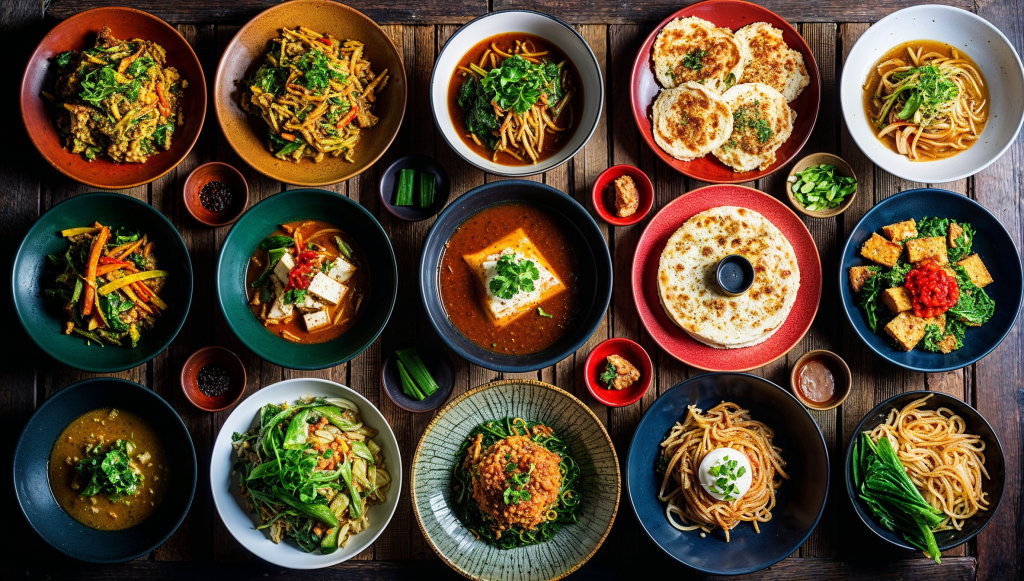Korean cuisine is renowned for its bold flavors, vibrant colors, and diverse ingredients. While many traditional dishes feature meat, there’s a wealth of vegetarian options that are equally delicious and satisfying. Whether you’re a lifelong vegetarian or simply looking to explore plant-based meals, Korean food offers an array of choices that highlight fresh vegetables, rice, and unique seasonings. Here’s a guide to some of the most delightful vegetarian Korean dishes you can enjoy.
Popular Vegetarian Korean Dishes
Bibimbap
- Bibimbap is a colorful rice bowl topped with an assortment of sautéed vegetables, gochujang (Korean chili paste), and often a fried egg. For a vegetarian version, simply omit the meat or ask for extra vegetables.
- Key Ingredients: Rice, assorted vegetables (like spinach, carrots, and zucchini), gochujang, sesame oil, and egg.
Japchae
- Japchae is a savory stir-fried dish made with sweet potato glass noodles, mixed vegetables, and a soy sauce-based seasoning. It’s naturally vegetarian and can be enjoyed warm or at room temperature.
- Key Ingredients: Sweet potato noodles, spinach, carrots, mushrooms, onions, and sesame oil.
Kimchi
- Kimchi is a staple in Korean cuisine made from fermented vegetables, usually napa cabbage or radishes. While traditional kimchi often contains fish sauce, many vegetarian versions are available that use soy sauce or other plant-based seasonings.
- Key Ingredients: Napa cabbage or radishes, chili pepper flakes (gochugaru), garlic, ginger, and green onions.
Sundubu Jjigae (Tofu Stew)
- This spicy stew features uncurdled tofu cooked with vegetables in a flavorful broth. Ensure you request a vegetarian version without seafood or meat.
- Key Ingredients: Soft tofu, zucchini, mushrooms, gochujang or gochugaru, and vegetable broth.
Pajeon (Korean Pancakes)
- Pajeon are savory pancakes made with green onions and various vegetables. They make for a great appetizer or snack and can be enjoyed with a soy dipping sauce.
- Key Ingredients: Flour, water, green onions, and optional vegetables like carrots or zucchini.
Vegetarian Kimbap
- Kimbap is similar to sushi but uses seasoned rice and various fillings wrapped in seaweed. Vegetarian options often include pickled vegetables, tofu, and egg.
- Key Ingredients: Rice, seaweed (gim), pickled radish (danmuji), cucumber, carrots, and tofu.
Tteokbokki
- Tteokbokki consists of chewy rice cakes stir-fried in a sweet and spicy sauce. Vegetarian versions are widely available and often include fish cakes; just ask for the plant-based option.
- Key Ingredients: Rice cakes (tteok), gochujang sauce, fish cake (optional), scallions.
Banchan (Side Dishes)
- Korean meals typically come with an array of banchan—small side dishes that can include pickled vegetables, seasoned greens (namul), and more. Many of these are vegetarian-friendly.
- Examples: Oi Muchim (spicy cucumber salad), seasoned spinach (sigeumchi namul), and kimchi.
Mushroom Hotpot (Beoseot Jeongol)
- A flavorful hotpot featuring various mushrooms and vegetables simmered in a savory broth. It’s perfect for sharing and can be customized to be completely plant-based.
- Key Ingredients: Assorted mushrooms (shiitake, enoki), tofu, napa cabbage, and vegetable broth.
Spicy Cucumber Salad (Oi Muchim)
- A refreshing salad made with cucumbers tossed in a spicy dressing of gochugaru (red pepper flakes), garlic, and sesame oil. It’s a perfect accompaniment to any meal.
- Key Ingredients: Cucumbers, garlic, gochugaru, sesame oil.

Where to Find Vegetarian Korean Food
- Korean Restaurants: Many Korean restaurants offer vegetarian options on their menus; look for those that highlight their commitment to accommodating dietary preferences.
- Asian Grocery Stores: Some Asian grocery stores have ready-made meals or ingredients to prepare your own vegetarian Korean dishes at home.
- Food Trucks & Street Vendors: In cities with vibrant food scenes, you might find food trucks or street vendors offering popular Korean street foods like tteokbokki or kimbap.
Korean cuisine offers an exciting variety of vegetarian dishes that are rich in flavor and texture. From hearty rice bowls to savory pancakes and spicy stews, there’s something for everyone to enjoy. Exploring vegetarian Korean food not only introduces you to new flavors but also highlights the versatility of plant-based ingredients in creating satisfying meals. Whether dining out at a restaurant or trying your hand at cooking these dishes at home, you’re sure to delight in the vibrant world of vegetarian Korean cuisine!
